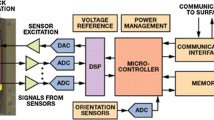Abstract
The presence of large current peaks on the power and ground lines is a serious concern for designers of synchronous digital circuits. Current peaks are caused by the simultaneous switching of highly loaded clock lines and by the signal propagation through the sequential logic elements. In this work we propose a methodology for reducing the amplitude of the current peaks. This result is obtained by clock skew optimization. We propose an algorithm that, for a given clock cycle time, determines the clock arrival time at each flip-flop in order to minimize the current peaks while respecting timing constraint. Our results on benchmark circuits show that current peaks can be reduced without penalty on cycle time and average power dissipation. Our methodology is therefore well-suited for low-power systems with reduced supply voltage, where low noise margins are a primary concern.
Similar content being viewed by others
References
E. Friedman (Ed.), Clock Distribution Networks in VLSI Circuits and Systems, IEEE Press, 1995.
R. Tsay, “An exact zero-skew clock routing algorithm,” IEEE Transactions on CAD of Integrated Circuits and Systems, Vol. 12, No. 2, pp. 242-249, Feb. 1993.
J.-D. Cho and M. Sarrafzadeh, “A buffer distribution algorithm for high performance clock net optimization,” IEEE Transactions on VLSI Systems, Vol. 3, No. 1, pp. 84-97, March 1995.
N.-C. Chou et al., “On general zero-skewclock net construction,” IEEE Transactions on VLSI Systems, Vol. 3, No. 1, pp. 141-146, March 1995.
Actel, FPGA Databook and Design Guide, 1994.
T. Szymanski, “Computing optimal clock schedules,” Proceedings of the Design Automation Conference, pp. 399-404, 1992.
J. Fishburn, “Clock skew optimization,” IEEE Transactions on Computers, Vol. 39, No. 7, pp. 945-951, July 1990.
N. Shenoy, R. Brayton, and A. Sangiovanni-Vincentelli “Graph algorithms for clock schedule optimization,” Proceedings of the International Conference on Computer-Aided Design, pp. 132- 136, 1992.
K. Sakallah, T. Mudge, and O. Olukotun, “Analysis and design of latch-controlled synchronous digital circuits,” IEEE Transactions on CAD of Integrated Circuits and Systems, Vol. 11, No. 3, pp. 322-333, March 1992.
T. Burks and K. Sakallah, “Min-max linear programming and the timing analysis of digital circuits,” Proceedings of the International Conference on Computer-Aided Design, pp. 152-155, 1993.
J. Xi and W. Dai, “Useful-skew clock routing with gate sizing for low power design,” Proceedings of the Design Automation Conference, pp. 383-388, 1996.
S. Chowdury and J. Barkatullah, “Estimation of maximum currents in MOS IC logic circuits,” IEEE Transaction on CAD of Integrated Circuits and Systems, Vol. 9, No. 6, pp. 642-654, 1990.
J. Neves and E. Friedman, “Design methodology for synthesizing clock distribution networks exploiting nonzero localized clock skew,” IEEE Transactions on VLSI systems, Vol. 4, No. 2, pp. 286-291, June 1996.
E. Lawler, Combinatorial Optimization: Networks and Matroids, Holt, Rinehard and Winston, 1976.
K. Murty, Linear Programming, Wiley, 1983.
A. Bogliolo, L. Benini, and B. Riccò, “Power estimation of cellbased CMOS circuits,” Proceedings of the Design Automation Conference, pp. 433-438, 1996.
R. Horst and P. Pardalos (Ed.), Handbook of Global Optimization, Kluwer, 1995.
D. Goldberg, “Genetic algorithms in search,” Optimization and Machine Learning, Addison-Wesley, 1989.
M. Horowitz, “Clocking strategies in high performance processors,” Symposium on VLSI Circuits Digest of Technical Papers, pp. 50-53, 1996.
J. Yoo and G. Gopalakrishnan et al., “High speed counterflow-clocked pipelining illustrated on the design of HDTV sub-band vector quantizer chips,” Advanced Research on VLSI, Chapel Hill, 1995, pp. 112-118.
J. Xi and W. Dai, “Buffer insertion and sizing under process variations for low power clock distribution,” Proceedings of the Design Automation Conference, pp. 491-496, 1995.
Meta-Software Inc., Hspice User Manual, v. H9001, 1990.
A. Bogliolo, L. Benini, G. De Micheli, and B. Riccò, “Gatelevel current waveform simulation,” International Symposium on Low Power Electronics and Design, pp. 109-112, 1996.
J. Grefenstette, A User's Guide to GENESIS, 1990.
S. Yang, “Logic synthesis and optimization benchmarks user guide. Version 3.0,” MCNC Technical Report, 1991.
R. Brodersen (Ed.), Anatomy of a Silicon Compiler, Kluwer, 1992.
Epic Design Technology, Inc., PowerMill, v. 3.3, 1995.
R. San Martin and J. Knight, “Power-profiler: Optimizing ASICs power consumption at the behavioral level,” Proceedings of the Design Automation Conference, pp. 42-47, 1995.
T. Szymanski and N. Shenoy, “Verifying clock schedules,” Proceedings of the International Conference on Computer-Aided Design, pp. 124-131, 1992.
T. Burd, “Low-power CMOS library design methodology,” M.S. Report, University of California, Berkeley, UCB/ERL M94/89, 1994.
Author information
Authors and Affiliations
Rights and permissions
About this article
Cite this article
Benini, L., Vuillod, P., Bogliolo, A. et al. Clock Skew Optimization for Peak Current Reduction. The Journal of VLSI Signal Processing-Systems for Signal, Image, and Video Technology 16, 117–130 (1997). https://doi.org/10.1023/A:1007982806152
Published:
Issue Date:
DOI: https://doi.org/10.1023/A:1007982806152




